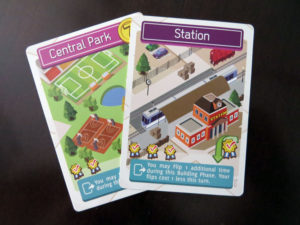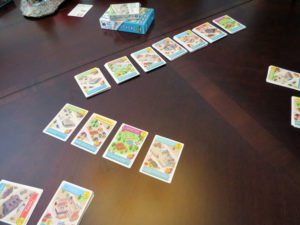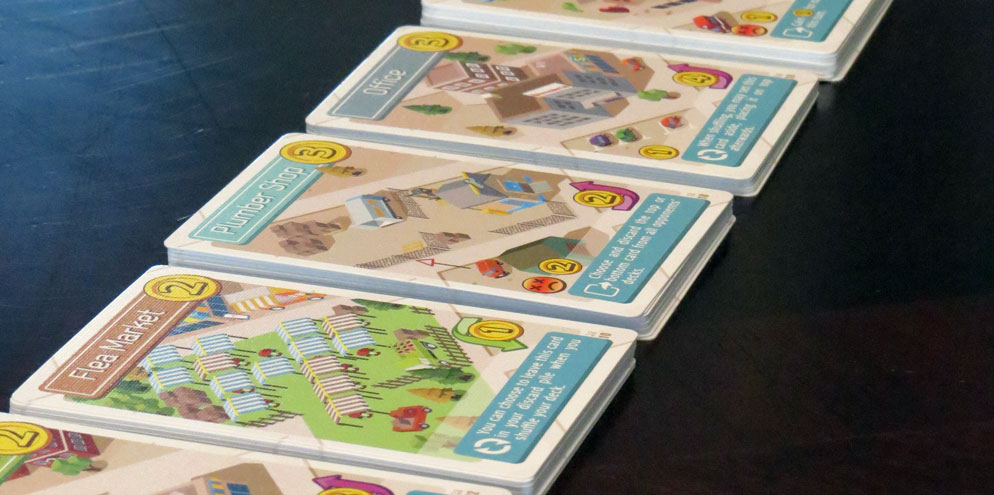 There are three reasons I introduced my coworkers to Tasty Minstrel Gaming’s Flip City card game during our lunchtime gaming sessions. The first is that, to the uninitiated, late game turns can look complicated enough to appear to be the magic of the dark arts (which they definitely aren’t); second, is the simple rule set can ease newcomers into the deep end of gaming; and the third is that the game is short enough to foster one-win-one-loss rivalries before anyone comes to check the status of your lunch hour.
There are three reasons I introduced my coworkers to Tasty Minstrel Gaming’s Flip City card game during our lunchtime gaming sessions. The first is that, to the uninitiated, late game turns can look complicated enough to appear to be the magic of the dark arts (which they definitely aren’t); second, is the simple rule set can ease newcomers into the deep end of gaming; and the third is that the game is short enough to foster one-win-one-loss rivalries before anyone comes to check the status of your lunch hour.
I can draw a one-to-one correlation between introducing this game and my coworkers discovering tabletop games on their own. Additionally, the good folks at TMG recently came out with an expansion called Flip City: Reuse so it felt like the perfect time for this review.
Flip City is a micro deck building card game that plays 1-4 players and works best with 3 or 4 players. The game can take around 40 minutes to play.
Game Overview:
In Flip City you are attempting to give your citizens the best neighborhood possible. This is done by collecting taxes (cash) to fund the construction of buildings (cards) that will get your citizens to give you medals (victory points). Tax them too much at once though, and they will get angry (sad faces). The game ends with the winning player revealing 8 victory points in a single turn.
Your city is represented by your deck and you grow your city by buying more buildings from the general supply. Different building cards give you different values of cash, victory points and/or sad faces, as well as descriptions with turn altering abilities (forced plays, additional win conditions, etc.).
Game Components:

The original game comes with 86 double-sided cards of 6 different variants. Flip City: Reuse adds 28 cards with 2 variants. The base set has a fold-out rules sheet in a pretty compact box that, I was pleasantly surprised to learn, literally accommodated the entire Reuse expansion box with room to spare. It could probably fit another whole expansion in there on top of Reuse, if I were to ditch the Reuse box. Although, I don’t think the box could handle the extra card thickness if you normally sleeve your cards.
However, there are plenty of ways to level up your game box to something bigger. I love the graphic design of both the base set and the expansion, as it is iconic, colorful and fitting for the level of play. On my first unboxing, the artwork reminded me of a certain city-building PC game of which I am sure we’ve all heard.
How to Play:
For the sake of brevity, this review will be of the multiplayer game, but fans of solitaire games might like to know that there is a solo variant in the rule book that is rather enjoyable.

All players start the game with the same set of building cards turned to the same flipped side. This is especially important as each card has a different building on each side. In the middle of the play area are the building stacks (the general supply) with their less valuable sides facing up. Each building has a purchase cost and a flip cost, as well as the number of coins, victory points and sad faces it earns the player.
The notable thing about this game is that there is no player hand – everything is played from the top of the deck, so all players always see the next card and some cards can even complicate your turn from the top of your deck.
The object of the game is to play 8 victory points in a single turn without exceeding your sad face limit (which, in the beginning of the game, is 2). Some card abilities will add to the sad face limit, remove sad faces all together, or even change the win condition.
There are three phases to a single turn in Flip City: Play Cards, Building and Turn End.
During the Play Cards phase, the player plays cards right from the top of her deck until she decides to stop or plays 3 sad faces, which auto-ends her turn (busting). At the end of the play cards phase, coinage (cash) and victory points are totaled up (assuming she did not bust). The game ends as soon as 8 victory points are played.
Assuming the player did not win, play moves to the Building Phase, in which the player can choose a single action. With the coinage acquired in the first phase, a building can be purchased from the general supply, a card in the player’s discard pile can be “recycled” (flipped), or a building can be purchased from the supply and flipped as a single action (developed).
The phase Turn End moves all the cards played and purchased into the discard pile. No cash, victory points, or sad faces carry into the next turn.

Game Experience:
Flip City is not the most intense drafting card game on the market by any means. Fans of long-turn combos with tons of card interaction will do better finding a home in other games, namely those that use a hand; TMG’s Cthulu Realms or Star Realms are better choices for these types of players.
What Flip City does well is combine push-your-luck and deck-building into a cohesive and compact gaming experience. It is perfect for new gamers (young and old) and has enough strategy baked-in initially for experienced gamers to have a fun time with it while they figure out what to do. Alternating win strategies between games also adds some fun to the mix for these players.

Design-wise, theme and mechanics jive well together and the cards and symbols are very easy to understand. Some ability descriptions could be a little more clear, but the FAQ on the rule sheet is robust enough to handle most of the questions that have come up. A QR code to the Watch It Played is also in the rule sheet, which may be helpful to some.
I also like that the bottom right corner of the cards shows the quantity of that card that belongs in the general supply, allowing for a player to ditch the box and rules to make it more transportable. The artwork and graphic design are fun and colorful and help to keep the game casual – which is exactly what it should be.
Very few of the 16 different card sides (only 2 in the base game and 1 in Reuse) actually allow interaction between the other players. The abundance of card copies in the general supply accommodates all of the players, so purchases made on a single player’s turn have very little effect on another player. There is little to no need to change a strategy mid-game or respond to something that happened on another player’s turn, so I’ve found that fans of push-your-luck games will eventually tire of the game once the strategies are all laid out.
The original win condition and the 4 card sides that give victory points make the game seem like it is on rails, so players new to the game tend to take a longer time developing their strategy as they search for some strategic shortcut. One card adds a second possible win condition of playing 18 cards in a turn, but it does not seem like enough variability.

As in most deck builders, additional buys and flips can be earned from different card abilities. Since the only way to prematurely end a turn is with sad faces, all players going for the original condition of 8 victory points are already trying to keep their turn going for as long as they can. It seems like the 18 card win was added to force the game to an end on those players who were running away with the win anyways.
That being said, I was hoping that the Reuse expansion was the answer to my problems. I wanted it to vary the win conditions (which it didn’t) or add more player interaction (which it only kind of did). The Reuse cards did not change any of the feel or flavor (which is good) or strategy (which is not good).
I do like how the expansion cards fit the original theme and mechanics; they certainly keep with a “reuse-reduce-recycle” theme and, for better or worse, don’t beat you over the head with it. Both expansion cards felt like cards from the original set, but frankly I have the original game already, and if the expansion doesn’t make the game feel expanded, then why expand it? I am sure I will find a way to incorporate the cards into a strategy eventually, but right now the payouts and abilities just don’t seem that useful.
As limited as it may be, I prefer the game in all its forms with more players due to the fact that there is more opportunity for player interaction. Two players are fine at getting the job done and the solo variant adds somewhat of a doomsday countdown to the mix, but with 3 and 4 players the game seems most at home.
Final Thoughts:

Flip City is a should-buy for gamers looking for a medium length casual game that can get some moderate mileage. I know I’m hard on the lack of player interaction and win condition, but I like this game a lot. I love the artwork and enjoy flipping cards back and forth to get some extra card combinations and I like how both complex and simple strategies can win the game.
Mechanically, Flip City does drive itself, which helps to make the rules feel streamlined; but ultimately it feels like the game was developed with mechanics first and win conditions second. I would have liked more anticipation and apprehension about what other players are doing on their turns.
As for the Reuse expansion, I could take it or leave it. It adds cards which helped to freshen up a few play throughs, but it ultimately doesn’t mix the game up enough (or remedy my issues) to make it a must-have.
Flip City is not overly complex (and I don’t think it is trying to be), which makes it perfect for new and young gamers. By the same token, the game takes too long to be played in between more intense games during a game night as a time filler. This places it in a difficult position for a game group, but perfectly for an office lunchtime play through. It is very fun and was only after many play throughs to the soundtrack of fluorescent humming that I grew tired of the same old strategies and wanted to introduce something with a bit more “gotcha” to my fellow cube mates.
There is undoubtedly substance in the foundation of Flip City and it is worth trying out, but depending on the players, its plays may be numbered from the start.
If you’d like to pick up a copy of Flip City, you can get it for about $15.
Final Score: 3.5 Stars – A solid foundation in the base game with some fun and original mechanics, but it could do with a better expansion to add some additional player interaction and/or win conditions to get that extra mileage.
 Hits:
Hits:
• Fun and cohesive design
• Easy to learn
• Great for new players
Misses:
• Little player interaction
• Too few win conditions
• Can grow tired for experienced players























